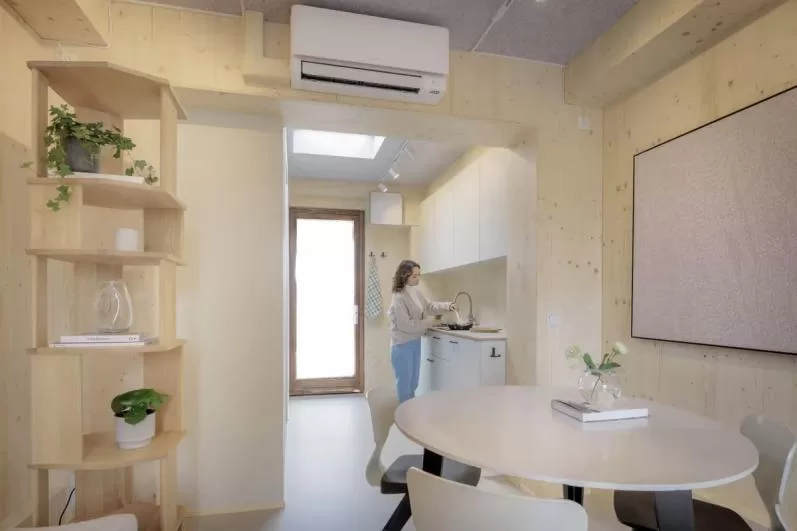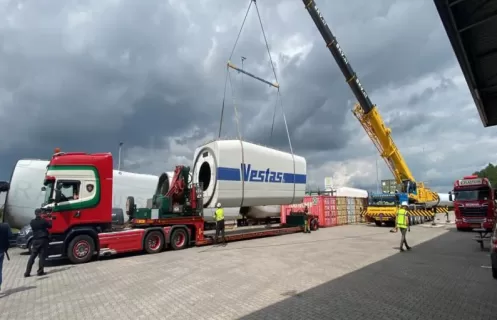What is a turbine house?
Wind turbines have been around us for a long while now, and so is the concept of reusing things.
In the mechanical structure of a wind turbine, there is the top most part of the mast that houses the generator, gearbox, brake assembly, and holds the blades, or rotors, in place; this structure is called the nacelle. The nacelle can now be converted into a habitable structure – a tiny turbine home, to say the least.
The project manager and the face of the innovation
Vattenfall, a Swedish electric and thermal producer, came up with the project and had it displayed at the Dutch Design Week – 2024. Their innovative concept is largely framed on sustainability, efficiency, and environmental conservation.
The project designer
The simple but sleek design for the nacelle reused as a house was done by the architecture and design company, Superuse. On the other hand, the structural implementations of the design were handled by Blade-Made, which is a spin-off company of Vattenfall, and Woodwave.
The nacelle: Original and Post-conversion specifications
The nacelle used for the tiny house is from a 20 year old V80 2MW turbine that had its home in Gols Wind Farm in Austria. The 100 meter high turbine supplied over 29,000 households with 73GWh of electricity annually for the two decades it was functional – as a power-producing-wind-turbine.
After the decommissioning of the turbine (after the two decades of service), the nacelle, now a tiny house, features a space that spans 4m wide, 10m long, and 3m high. This gives about 35 square meters of free, usable, habitable space.
The housing unit is just like your typical home as it features a living area, sleeping area, kitchenette, and a bathroom. At the exhibition, the interior was furnished with with wood and other sustainably-produced furniture, like a circuform table made using recycled materials from the wind turbine.
The house is also fitted with smart home features like solar panels that power an air conditioning unit, a water heater, and a electric vehicle charging port that is mounted on the exterior of the structure. The photovoltaic panels generate up to 1,800 W of power, which is fair for daily use.
The good
This innovation has proven its utility as it makes use of concepts that are arguably good with respect to the environment, costs, among other issues. This is as follows:
1. Reuse of structural components
In as much as recycling is good for the environment, reuse, in this specific instance, proves more friendly and better suited for the job.
Recycling of the materials from the turbines has downsides like green house gas emissions; and the process is very energy intensive in the long run. On the other hand, reuse of these materials has proven to be equally good when referencing structural and design aspects of the materials used for the house.
2. Environmental sustainability
The tiny houses not only utilize mechanisms like reusing of materials, but also use of recycled materials, and green energy. All these processes are in themselves very sustainable and friendly to the environment.
3. Tackling the housing issue
If the tiny house finally hits the housing market and gets a good reception, it will have opened an avenue for tackling housing shortages in given areas that need cost-effective, self-contained houses fast.
This will of course not solve the issue in a large-scale context because there just isn’t that many of turbine nacelles to re-use and make, say, millions of the tiny houses. This is especially so from a short term view. All in all, it will still have addressed the issue.
4. Cost
The tiny house proves to be cost-effective because all that is needed of the nacelles is decommissioning and housing approvals from the authorities concerned.
The interior furnishing, electrical fitting, and plumbing installations are also conceptually not that expensive, especially if done in large-scale.
The bad
As with most innovations, the concept of the tiny house does not fall short of downsides. It should still be kept in mind that the disadvantages are usually the means to improvement. Some of these include:
1. Sacrifice on comfort
The whole space is approximately 40 square meters at a maximum. It features all its 4 rooms – the kitchenette, living area, “bedroom”, and the bathroom – in this tiny space. This will definitely not meet the comfort standards of anyone one after “comfortability” in the housing market.
Improvements can however be made through joining up several nacelles to make larger spaces, or even making use of the more recent turbines that feature more spacious nacelles, like the Dongfang turbine that is the largest in the word right now.
2. Concerns on the health safety of the fiber-glass materials used to make the nacelle.
Wind turbines are built with durability and weight-efficiency in mind, and what a better material to use other than reinforced polymers.
The glass-fiber reinforced materials used for the nacelles have however been previously marked as a cause for respiratory and dermatological problems, with some studies even considered it carcinogenic. According to US Occupational Safety and Health Administration (OSHA), products with the reinforced material need to be labelled correctly for any health hazard they may present.
This is however not an objective cause of worry as several studies have found it safe for use. This can be professed by the housing approval that the turbine house got from the Swedish authorities.
The case here is thus subjective for the most part, till proven otherwise (like asbestos use in houses).
The future of the innovation
Innovation is the engine of the future, and the strides taken by Vattenfall is a testament to that. It may not be the million-dollar answer to some of the major problems we are facing globally at the moment, but it is eminently a bold step towards the achievement of some of the solutions that the are greatly needed right now.



